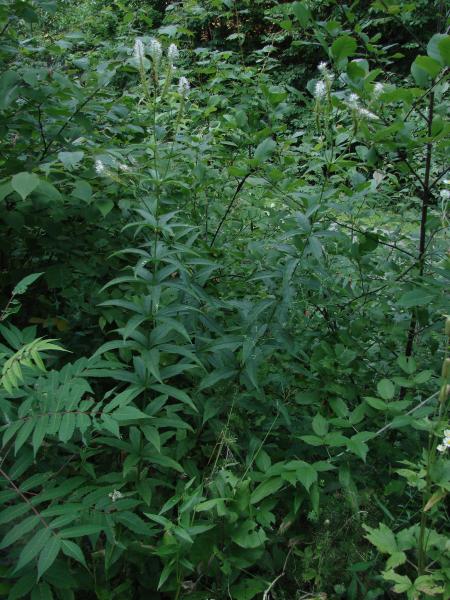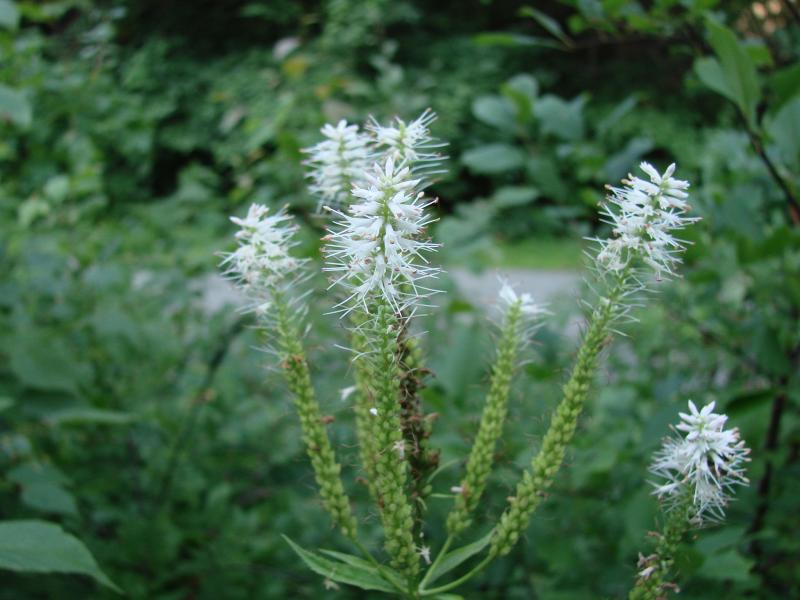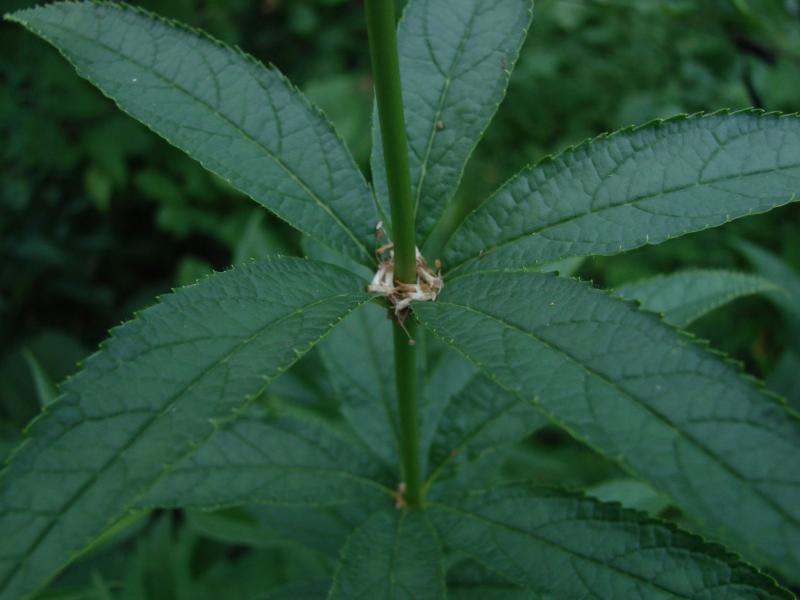Culver's Root
Veronicastrum virginicum (L.) Farw.
- Class
- Dicotyledoneae (Dicots)
- Family
- Plantaginaceae (Plantain Family)
- State Protection
- Threatened
Listed as Threatened by New York State: likely to become Endangered in the foreseeable future. For animals, taking, importation, transportation, or possession is prohibited, except under license or permit. For plants, removal or damage without the consent of the landowner is prohibited.
- Federal Protection
- Not Listed
- State Conservation Status Rank
- S2
Imperiled in New York - Very vulnerable to disappearing from New York due to rarity or other factors; typically 6 to 20 populations or locations in New York, very few individuals, very restricted range, few remaining acres (or miles of stream), and/or steep declines.
- Global Conservation Status Rank
- G4
Apparently Secure globally - Uncommon in the world but not rare; usually widespread, but may be rare in some parts of its range; possibly some cause for long-term concern due to declines or other factors.
Summary
Did you know?
Culver's-root is a popular garden plant and available in many native plant nurseries in the Northeast. Its large size and showy spikes of white flowers and whorled leaves are a beautiful addition to an early-summer perennial garden, especially if you want to help feed the bees and bumblebees. There are a number of cultivars available now. The common name comes from a mysterious Dr. Culver (or Coulvert), an early pioneer physician who used it in his practice since it had many medicinal uses, beginning with Native Americans (Wikipedia contributors).
State Ranking Justification
There are 16 verified occurrences. There are about 40 historical occurrences.
Short-term Trends
The short term trend is unknown, given that known populations have only been surveyed once.
Long-term Trends
The long term trend indicates a somewhat significant decline as the known populations have declined to 16 from the 40 historically documented. Additional survey efforts are needed is determine the overall trend for this species.
Conservation and Management
Threats
The known populations are threatened by increased mowing, along with habitat alteration and loss due to incompatible management or corridor, including driveway, improvements. The collection for medicinal uses may also threaten this plant. Other potential threats include loss of habitat through competition with invasive plant species and the loss of local native genotypes thorough interbreeding with cultivated varieties or non-local ecotypes.
Conservation Strategies and Management Practices
Time mowing and other compatible habitat management efforts to occur during the growing season but outside the period of flowering and fruiting. Avoid the application of herbicides and repeated mowing during the growing season. Monitor populations for impacts from deer browse, habitat loss to competition from invasive species. and loss of habitat suitability due to excessive shading. Protect the populations from direct disturbance from trail expansion or development.
Research Needs
Additional survey work is needed both to locate new populations and at the historical records with specific locational information, to determine if those populations remain extant. Clear and consistent estimates of population size at extant populations is needed to help determine the trend of this species.
Habitat
Habitat
In New York the few known sites for Veronicastrum virginicum are forest edges, including along bike trails and driveways. It has been found on north or northwest-facing slopes as well as along the bottomlands of major rivers (New York Natural Heritage Program 2010). Prairie remants, fens, and meadows; river banks; deciduous woodlands (especially with oaks); and adjacent roadsides (Voss 1996). Moist and dry upland woods and prairies (Gleason and Cronquist 1991).
Associated Ecological Communities
- Floodplain forest*
(guide)
A hardwood forest that occurs on mineral soils on low terraces of river floodplains and river deltas. These sites are characterized by their flood regime; low areas are annually flooded in spring, and high areas are flooded irregularly.
- Maple-basswood rich mesic forest*
(guide)
A species rich hardwood forest that typically occurs on well-drained, moist soils of circumneutral pH. Rich herbs are predominant in the ground layer and are usually correlated with calcareous bedrock, although bedrock does not have to be exposed. The dominant trees are sugar maple, basswood, and white ash.
- Successional old field*
A meadow dominated by forbs and grasses that occurs on sites that have been cleared and plowed (for farming or development), and then abandoned or only occasionally mowed.
- Unpaved road/path*
A sparsely vegetated road or pathway of gravel, bare soil, or bedrock outcrop. These roads or pathways are maintained by regular trampling or scraping of the land surface. The substrate consists of the soil or parent material at the site which may be modified by the addition of local organic material (woodchips, logs, etc.) or sand and gravel. Abandoned railroad beds where tracks have been removed are included here. One characteristic plant is path rush.
* probable association but not confirmed.
Associated Species
- Carpinus caroliniana
- Carya cordiformis (bitternut hickory)
- Cornus rugosa (round-leaved dogwood)
- Diervilla lonicera (bush-honeysuckle)
- Fraxinus pennsylvanica (green ash)
- Hydrangea arborescens (wild hydrangea)
- Lonicera morrowii (Morrow's honeysuckle)
- Pinus strobus (white pine)
- Prunus virginiana
- Quercus alba (white oak)
- Quercus rubra (northern red oak)
- Rosa multiflora (multiflora rose)
- Tilia americana
- Ulmus americana (American elm)
Range
New York State Distribution
Populations are scattered throughout New York, south of the Adirondacks.
Global Distribution
Culver's root is found from southeastern Manitoba and southwestern Ontario to Maine, south to Florida and Texas. It is known only from historical records in Louisiana, and North Dakota and the Maine populations are the result of introductions.
Identification Comments
Identifying Characteristics
Culver's-root is a large, showy, herbaceous perennial. Plants have erect, unbranched stems reaching 80 cm to 2 m in height. Each stem has many whorls of 3 to 7 narrow, lanceolate, to lance-ovate, somewhat stiff, finely serrate leaves that are typically hairy on their underside. The inflorescence is a showy, branched, terminal raceme 6 to 15 cm long and densely packed with small (7 - 9 mm long) tube-like white or pink flowers with two exerted stamens.
Best Life Stage for Proper Identification
Culver's root is most easily found when in flower, though fruiting and possibly even sterile specimens may also be identified. Flowering typically occurs from early July through late August.
Similar Species
When in flower or fruit Culver's root does not closely resemble any other plant species due to its unique combination of unbranched upright stems, height, slender spike-like racemes resembling an extended candelabra, and numerous sets of narrowly whorled leaves.
Best Time to See
Veronicastrum typically flowers in late summer, and the fruits are present from late August into October.
- Flowering
- Fruiting
The time of year you would expect to find Culver's Root flowering and fruiting in New York.
Culver's Root Images
Taxonomy
Culver's Root
Veronicastrum virginicum (L.) Farw.
- Kingdom Plantae
- Phylum Anthophyta
- Class Dicotyledoneae
(Dicots)
- Order Plantaginales
- Family Plantaginaceae (Plantain Family)
- Order Plantaginales
- Class Dicotyledoneae
(Dicots)
- Phylum Anthophyta
Synonyms
- Veronica virginica L.
Additional Resources
References
APSU Center for Field Biology and University of Tennessee Herbarium. 1999. October 6-last update. Atlas of Tennessee Vascular Plants. Online. Available: http://www.bio.utk.edu/botany/herbarium/vascular/atlas.html. Accessed 2000-Jan.
Amoroso, Jame. Personal communication. Botanist. North Carolina Heritage Program, NC Dept. of Environment, Health, & Natural Resources, Division of Parks And Recreation, Raleigh, NC.
Beckstrom-Sternberg, S.M., D.E. Moerman, and J.A. Duke. 1995. Medicinal plants of native America database. Online. Available: http://ars-genome.cornell.edu/cgi-bin/WebAce/webace?db=mpnad b. Accessed 2000, January 7.
Boyle, K., C. Eastman, and T. Mousseau. South Carolina plant atlas. Online. Available: http://cricket.biol.sc.edu/herb. Accessed 2000, January 7.
Brunet, David. Botanist, Louisiana Natural Heritage Program. Personal communication.
Cooperrider, T.S. 1995. The Dicotyledoneae of Ohio. Ohio State University Press, Columbus.
Cusick, A. Botanist, Ohio Natural Heritage Program. Personal communication.
Davidson, Campbell. Director, Morden Research Centre, Agriculture and Agri-Food Canada. Personal communication.
Fernald, M. L. 1950. Gray's manual of botany. 8th edition. Corrected printing (1970). D. Van Nostrand Company, New York. 1632 pp.
Ford, B. Personal communication. Professor and Curator of the University of Manitoba Herbarium, University of Manitoba, Winnipeg, MB.
Freeman, Craig. Personal communication. Botanist, Kansas Natural Features Inventory. Kansas Biological Survey, Lawrence, KS.
Gleason, H.A. 1952. The new Britton and Brown illustrated flora of the northeastern United States and adjacent Canada. 3 volumes. Hafner Press, New York. 1732 pp.
Gleason, Henry A. and A. Cronquist. 1991. Manual of Vascular Plants of Northeastern United States and Adjacent Canada. The New York Botanical Garden, Bronx, New York. 910 pp.
Greenall, Jason. Botanist, Manitoba Department of Natural Resources. Personal communication.
Haines, A. and T.F. Vining. 1998. Flora of Maine, A Manual for Identification of Native and Naturalized Vascular Plants of Maine. V.F.Thomas Co., Bar Harbor, Maine.
Holmgren, Noel. 1998. The Illustrated Companion to Gleason and Cronquist's Manual. Illustrations of the Vascular Plants of Northeastern United States and Adjacent Canada. The New York Botanical Garden, Bronx, New York.
Kartesz, J.T. 1999. A synonymized checklist and atlas with biological attributes for the vascular flora of the United States, Canada, and Greenland. First edition. In: Kartesz, J.T., and C.A. Meacham. Synthesis of the North American Flora, Version 1.0. North Carolina Botanical Garden, Chapel Hill, N.C.
Kindscher, K. 1992. Medicinal wild plants of the prairie: An ethnobotanical guide. University Press of Kansas, Lawrence.
Lakela, O. 1965. A Flora of Northeastern Minnesota. University of Minnesota Press, Minneapolis, Minnesota. 541 pp.
Looman, J. and K. Best. 1979. Budd's flora of the Canadian Praire Provinces. Agriculture Canada, Research Branch Publication 1662.
McAvoy, Bill. Personal communication. Botanist, Delaware Natural Heritage Program.
McGuffin, Michael. Personal communication. American Herbal Products Association, Silver Spring MD
McHale, Maureen. Natural Features Inventory Biologist, The Nature Conservancy/Missouri Department of Conservation. Personal communication.
Mitchell, Richard S. and Gordon C. Tucker. 1997. Revised Checklist of New York State Plants. Contributions to a Flora of New York State. Checklist IV. Bulletin No. 490. New York State Museum. Albany, NY. 400 pp.
Moerman, D.E. Native American Ethnobotany: a database of foods, drugs, dyes and fibers of Native American peoples, derived from plants. University of Michigan, Dearborn, MI. Online. Available: http://www.umd.umich.edu/cgi-bin/herb
Moorhead, William. Botanist, Connecticut Natural Diversity Database. Personal communication.
New York Natural Heritage Program. 2024. New York Natural Heritage Program Databases. Albany, NY.
Ode, David. Botanist/Ecologist, South Dakota Natural Heritage Database. Personal communication.
Oldham, Michael. Personal communication. Botanist, Ontario Natural Heritage Information Centre.
Popp, Robert. Heritage Coordinator/Botanist, Vermont Nongame and Natural Heritage. Personal communication.
Punter, C. Elizabeth. Special Projects Botanist, Manitoba Conservation Data Centre. Personal communication.
Radford, A.E., H.E. Ahles, and C.R. Bell. 1968. Manual of the vascular flora of the Carolinas. Univ. North Carolina Press, Chapel Hill, NC. 1183 pp.
Scoggan, H.J. 1978-1979. The flora of Canada: Parts 1-4. National Museums Canada, Ottawa. 1711 pp.
Smith, Tim. Personal communication. Botanist, Missouri Department of Conservation. Missouri Department of Conservation, Jefferson City, MO
Steyermark, J.A. 1963. Flora of Missouri. Iowa State Univ. Press, Ames. 1728 pp.
U.S. Department of Agriculture. 1997. July 16-last update. Western wetland flora: Field office guide to plant species. Online. Available: http://www.npwrc.usgs.gov/resource/othrdata/westflor/westflor.htm. Accessed 2000, January 7.
Voss, E.G. 1985. Michigan flora. Part II. Dicotyledons. Cranbrook Institute of Science and University of Michigan Herbarium. Ann Arbor, Michigan. 1212 pp.
Voss, E.G. 1996. Michigan Flora. Part III. Dicots (Pyrolaceae-Compositae). Cranbrook Institute of Science Bulletin 61 and Univ. Michigan Herbarium. Ann Arbor, Michigan. 622 pp.
Weldy, T. and D. Werier. 2010. New York flora atlas. [S.M. Landry, K.N. Campbell, and L.D. Mabe (original application development), Florida Center for Community Design and Research http://www.fccdr.usf.edu/. University of South Florida http://www.usf.edu/]. New York Flora Association http://newyork.plantatlas.usf.edu/, Albany, New York
Welsh, S.L., N.D. Atwood, S. Goodrich, and L.C. Higgins (eds.) 1993. A Utah flora. 2nd edition. Brigham Young Univ., Provo, Utah. 986 pp.
Westad, Kristin. Wisconsin Natural Heritage Inventory. Personal communication.
Links
About This Guide
Information for this guide was last updated on: January 6, 2016
Please cite this page as:
New York Natural Heritage Program. 2024.
Online Conservation Guide for
Veronicastrum virginicum.
Available from: https://guides.nynhp.org/culvers-root/.
Accessed July 27, 2024.


